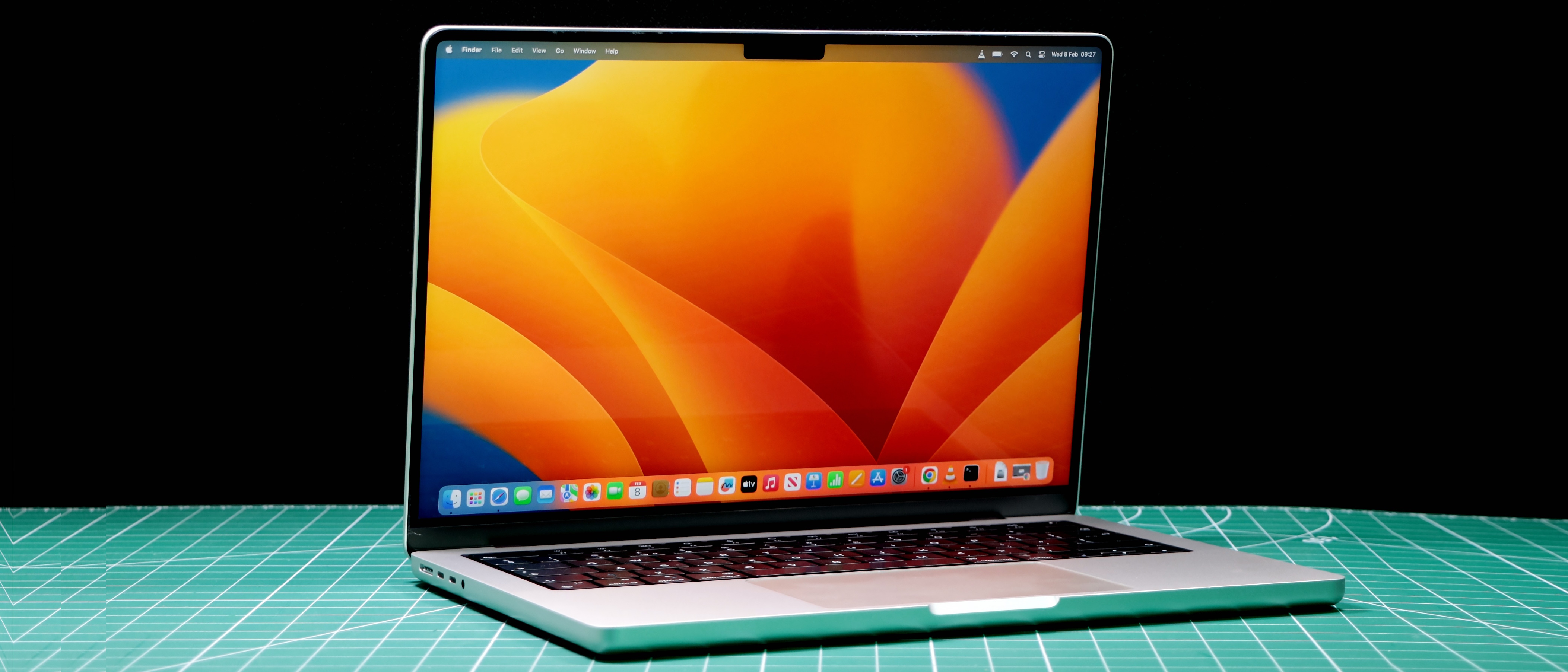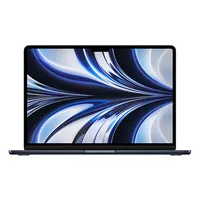TechRadar Verdict
The MacBook Pro 14-inch (2023) is a fantastic mobile workstation that brings the power of the new M2 Pro and M2 Max chips to a compact and portable laptop. It keeps the same design as the 2021 model, but that's no bad thing given the brilliant screen and solid build quality.
Pros
- +
New M2 Pro and M2 Max chips
- +
Almost 20-hour battery life
- +
The best screen on a laptop
Cons
- -
Expensive
- -
Price rise for UK and Australia
Why you can trust TechRadar
Apple MacBook Pro 14-inch (2023): Two-minute review
The MacBook Pro 14-inch (2023) is the second iteration of Apple’s (slightly more) compact laptops for professionals, and this model comes with a choice of the new M2 Pro and M2 Max chips – the same processors that power its bigger sibling, the MacBook Pro 16-inch (2023).
The original 14-inch MacBook Pro was launched in 2021. At the time, it was easily one of the best laptops ever made, and it earned a rare five stars from yours truly. This left Apple with a bit of a conundrum, however: how do you improve on (near) perfection?
It seems, according to Apple at least, that the answer to that question is to offer an iterative update, rather than a huge overhaul. That may not sound as exciting as the genuinely new and innovative 14-incher Apple released in 2021, but the end result is another excellent laptop for creative professionals.
The MacBook Pro 14-inch (2023) starts at $1,999 / £2,149 / AU$3,199, which makes it a hefty investment and puts it beyond the reach of many. You should, then, think carefully about whether or not you need the kind of performance and power that the MacBook Pro 14-inch (2023) promises – and it promises a lot.

There is some good news on the price front for US customers at least, as there the base price of the MacBook Pro 14-inch (2023) remains the same as the 2021 model. However, if you're outside the US you’ll be faced with a price hike, which is a real shame, and will make this laptop harder to justify for many people.
As with previous models, as well as the 16-inch variant, you have quite a bit of flexibility as to how you can configure the MacBook Pro 14-inch (2023). You can choose the amount of unified memory and storage that are appropriate for your needs, and you can also choose between the M2 Pro or M2 Max chips, though unsurprisingly the already-high price tag can start climbing steeply as you upgrade certain components.
On the design front, nothing has changed, with the 2023 model looking identical to the 2021 model. That’s no bad thing, as that means you still get one of the best displays you can find on a laptop: a 14.2 Liquid Retina XDR mini-LED screen that runs at a resolution of 3024 x 1964, with a refresh rate of up to 120Hz.
Sign up for breaking news, reviews, opinion, top tech deals, and more.
You also get plenty of ports to plug in peripherals (including a memory card slot, which will be particularly welcome for photographers), a responsive and satisfying keyboard, and a very good 1080p webcam.
While keeping the same design as the previous model means the MacBook Pro 14-inch (2023) is a less revolutionary release than its predecessor, it’s a competent and confident one – and under the hood is where the real action is.
I tested the MacBook Pro 14-inch with the M2 Pro chip, 32GB of unified memory and a fast 2TB, and I can confidently state that this is one of the best-performing laptops I’ve used. The macOS Ventura operating system felt fast and responsive, apps loaded quickly, and even the most intensive tasks, such as 8K video editing, were handled with ease. Thanks to the power of the M2 Pro chip, I was able to scrub through 8K video, edit footage and preview my changes without having to render the preview, making the whole workflow much faster. It’s in such scenarios that the high price of the MacBook Pro 14-inch (2023) becomes more justifiable.
The M2 Pro chip is impressively efficient too, and that means the MacBook Pro 14-inch (2023) has exceptional battery life, lasting more than 19 hours on a single charge. Even better, there's no noticeable drop in performance when the MacBook Pro 14-inch is unplugged, which means you should be able to be just as productive on battery power as when you’re plugged in and at a desk.
All of this means that from a professional standpoint, and especially for creatives, the high price of the MacBook Pro 14-inch (2023) makes more sense. This is an investment that can help speed up workloads, potentially allowing you to take on more clients, and you shouldn’t feel the need to upgrade for a long time. If you don’t need the power, however, your money will be better off spent elsewhere.

Apple MacBook Pro 14-inch (2023) review: Price and availability
- Starts at $1,999 / £2,149 / AU$3,199
- Price increase in UK and Australia
- Cheaper than the 16-inch model
The MacBook Pro 14-inch (2023) went on sale on January 24, 2023, alongside the larger MacBook Pro 16-inch (2023) and new Mac mini (2023).
As mentioned, and as with the larger model, for US customers Apple hasn’t increased the base price of the MacBook Pro 14-inch (2023) compared to the previous edition, so for $1,999 you get the 14-inch MacBook Pro with 512GB storage and the M2 Pro chip.
The fact that Apple hasn’t upped the price of the base model in the US despite the new hardware is certainly welcome, so if you were considering getting the 14-inch MacBook Pro already, you now get a nice extra boost in performance.
At the higher end, the M2 Max version starts at $3,099 – that's slightly more expensive than its predecessor, but only by $100. If you want to go all-out, there are a bunch of optional extras here, including more powerful versions of the M2 Pro and M2 Max chips, and additional memory and storage.
If you fully kit out your MacBook Pro 14-inch with the most powerful M2 Max chip at the maxed-out configuration (not including any of the preinstalled software options like Final Cut Pro) it'll cost a hefty $6,299.
However, while Apple has kept the price of the base model the same between generations in the US, UK and Australian buyers are going to notice a price rise.
In the UK, the MacBook Pro 14-inch (2023) starts at £2,149, a rather large leap from the £1,899 the previous model began at. By breaking the psychological £2,000 barrier, the MacBook Pro 14-inch (2023) instantly feels like a much bigger investment, and it could dissuade some people from buying it.
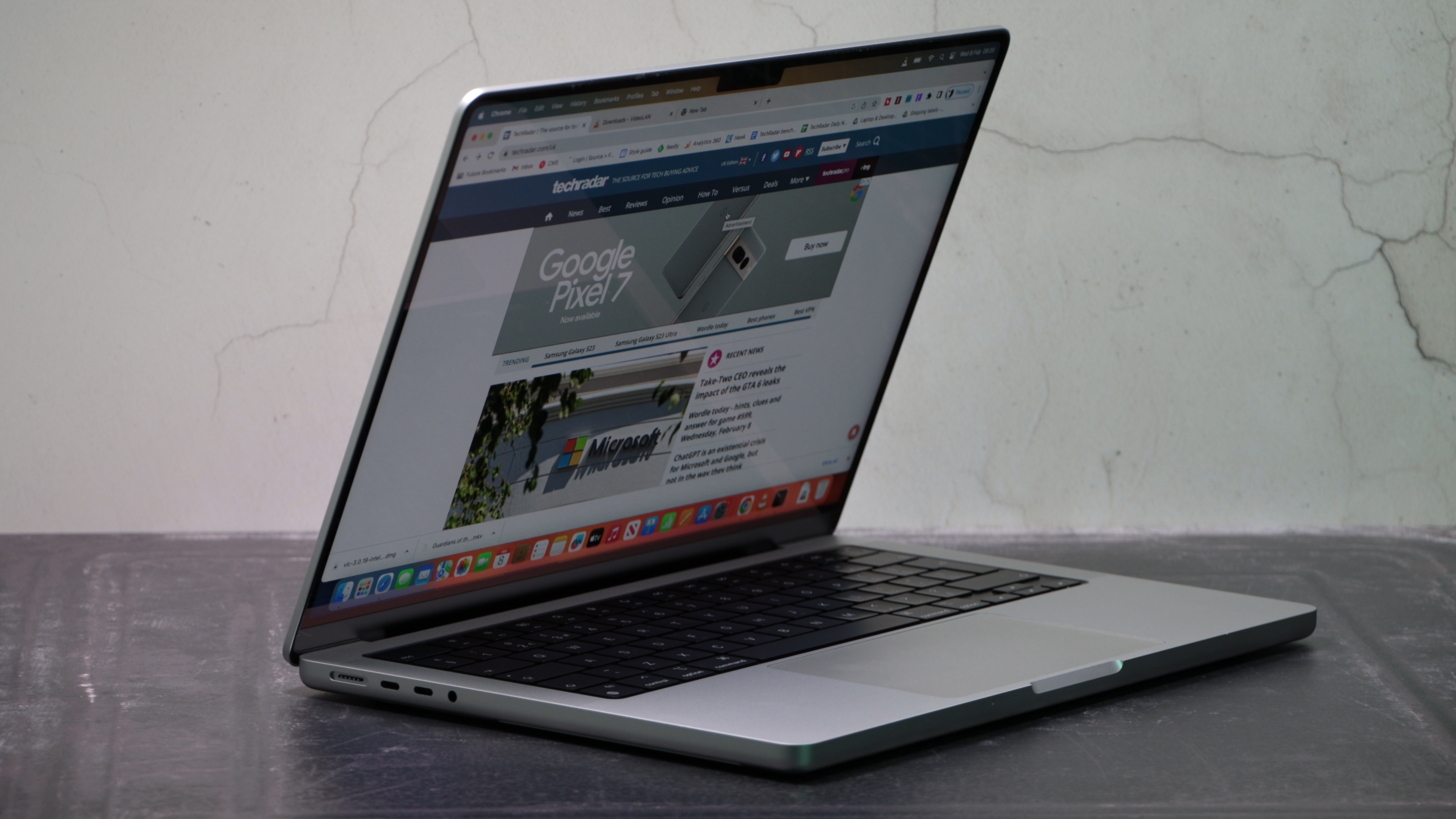
The M2 Max model, meanwhile, starts at £3,349, and the fully specced-out M2 Max version will cost £6,549.
In Australia, prices start from AU$3,199 for the base-spec M2 Pro model. Upgrading to a 1TB SSD will set you back AU$3,999, while picking up the higher-end M2 Pro Max will cost you AU$4,999.
Once again, the base model in Australia gets a price increase, as the previous model started at AU$2,999.
It’s a real shame that UK and Australian customers don’t get the price freeze that US customers do, and it makes the MacBook Pro 14-inch (2023) slightly harder to recommend. If you’re not entirely sure that you need the kind of power and performance that Apple offers with this laptop, you’d be better off looking at something cheaper, such as the MacBook Pro 13-inch (M2, 2022).
While the $1,999 / £2,149 / AU$3,199 base price of the new MacBook Pro 14-inch is high, especially outside of the US, it remains quite a bit cheaper than the base model of the 16-inch model, which costs $2,499 / £2,699 / AU$3,999. As with the previous generation, both the 14-inch and 16-inch models have roughly the same specs, so if you don’t need the larger screen size, and want a more easily-portable laptop, the 14-inch MacBook Pro is definitely the one to get.
- Price score: 4/5
Apple MacBook Pro 14-inch (2023) review: Specs
The MacBook Pro 14-inch (2023) comes in three main configurations, two with the M2 Pro chip and one with the M2 Max chip.
| MacBook Pro M2 Pro 512GB | MacBook Pro M2 Pro 1TB | MacBook Pro M2 Max | |
|---|---|---|---|
| Price: | $1,999 / £2,149 / AU$3,199 | $2,499 / £2,699 / AU$3,999 | $3,099 / £3,349 / AU$4,999 |
| CPU: | Apple M2 Pro (10-core) | Apple M2 Pro (12-core) | Apple M2 Max (12-core) |
| Graphics: | Integrated 16-core GPU | Integrated 19-core GPU | Integrated 30-core GPU |
| RAM: | 16GB unified memory | 16GB unified memory | 32GB unified memory |
| Screen: | 14.2-inch, 3024 x 1964 Liquid Retina XDR display (mini-LED, 1,000 nits sustained brightness, wide color P3 gamut, ProMotion technology) | 14.2-inch, 3024 x 1964 Liquid Retina XDR display (mini-LED, 1,000 nits sustained brightness, wide color P3 gamut, ProMotion technology) | 14.2-inch, 3024 x 1964 Liquid Retina XDR display (mini-LED, 1,000 nits sustained brightness, wide color P3 gamut, ProMotion technology) |
| Storage: | 512GB SSD | 1TB SSD | 1TB SSD |
| Ports: | 3x Thunderbolt 4 (USB-C), HDMI, SDXC card slot, 3.5mm headphone jack, MagSafe 3 | 3x Thunderbolt 4 (USB-C), HDMI, SDXC card slot, 3.5mm headphone jack, MagSafe 3 | 3x Thunderbolt 4 (USB-C), HDMI, SDXC card slot, 3.5mm headphone jack, MagSafe 3 |
| Wireless: | Wi-Fi 6e (802.11ax), Bluetooth 5.3 | Wi-Fi 6e (802.11ax), Bluetooth 5.3 | Wi-Fi 6e (802.11ax), Bluetooth 5.3 |
| Camera: | 1080p FaceTime HD webcam | 1080p FaceTime HD webcam | 1080p FaceTime HD webcam |
| Weight: | 3.5 lbs (1.6kg) | 3.5 lbs (1.6kg) | 3.6 lbs (1.63kg) |
| Dimensions: | 12.31 x 8.71 x 0.61 inches (313 x 221 x 16mm) | 12.31 x 8.71 x 0.61 inches (313 x 221 x 16mm) | 12.31 x 8.71 x 0.61 inches (313 x 221 x 16mm) |
Each of these options can be configured to change the chips, add more memory (up to 32GB with the M2 Pro, and up to 96GB with the M2 Max), and add storage up to 8TB.

Apple MacBook Pro 14-inch (2023) review: Design
- Same design as previous model
- Plenty of ports
- Best screen on a laptop
The MacBook Pro 14-inch (2023) looks identical to the previous model, but that’s no bad thing. After all, the 2021 14-inch MacBook Pro was an entirely new form factor for Apple, so to expect it to give the laptop a major design overhaul for only the second version would be a little unfair.
It helps that the MacBook Pro 14-inch design was already pretty much perfect. You get a laptop with dimensions of 12.31 x 8.71 x 0.61 inches (31.26 x 22.12 x 1.55cm), which is noticeably smaller than the 16-inch design, with a 14.2-inch display.
That display, along with the one on the new 16-inch MacBook Pro, is easily one of the best you can get on a laptop right now, thanks to the Liquid Retina XDR and mini-LED technology that deliver incredibly vibrant colors and rich, deep contrast. As with the larger display, the 14-inch MacBook Pro’s screen supports ProMotion adaptive refresh rates of up to 120Hz, which makes macOS and its apps feel wonderfully smooth and responsive (scrolling down websites is a particular joy).
The 14.2-inch screen has a sharp resolution of 3024 x 1964, and while that’s lower than the 3456 x 2234 resolution of the 16-inch MacBook Pro’s display, because of the size difference, both screens share the same pixel density of 254 pixels per inch, so there’s no difference in image quality depending on which screen size you go for. If you find larger screens more comfortable to work on, go for the 16-inch model, but if you’d rather have something that’s compact and easy to take with you, I’d recommend the 14-inch.
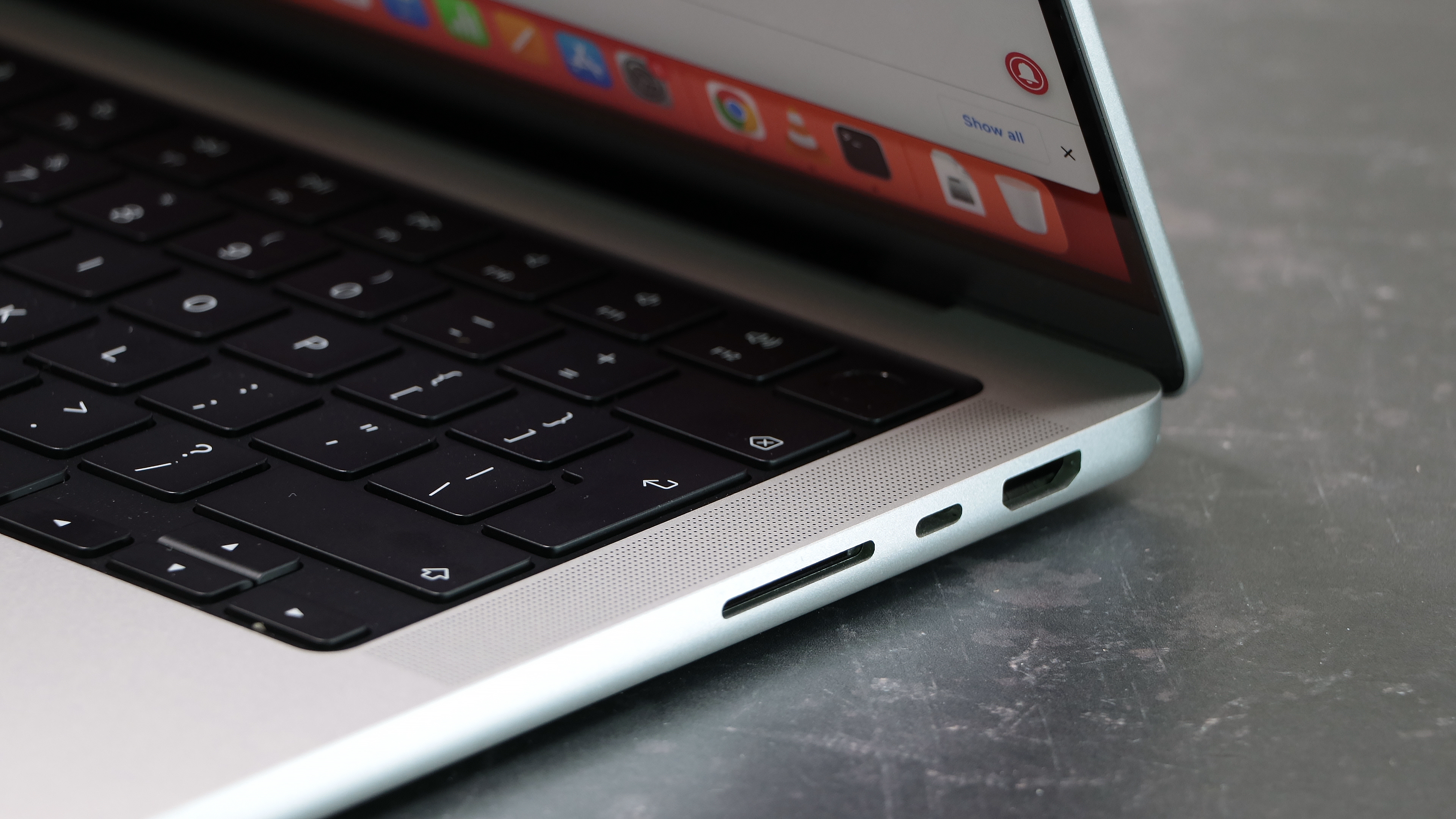
The 14-inch MacBook Pro comes with a good selection of ports, including an SDXC card slot, a HDMI port, a 3.5mm headphone jack, and three Thunderbolt 4 (USB-C) ports. This gives you a decent amount of flexibility in terms of the peripherals you can attach, and it should hopefully mean you don’t have to resort to dongles or adaptors; it also makes the MacBook Pro 14-inch all the more portable, especially for creative professionals and hobbyists.
There’s also a MagSafe 3 port, which allows you to connect the proprietary MagSafe 3 power lead, which quickly and easily snaps into position using magnets. Not only is this convenient, it means that it detaches safely if the cord is pulled, without damaging the port.
Overall, the design of the MacBook Pro 14-inch is excellent, with a solid build quality, plenty of ports and the best screen you can get on a laptop. The fact that it’s more compact than the 16-inch model, without making any sacrifices in screen quality or port selection is commendable, and makes it a compelling option for anyone who needs a powerful workstation laptop and travels a lot.
- Design score: 5/5
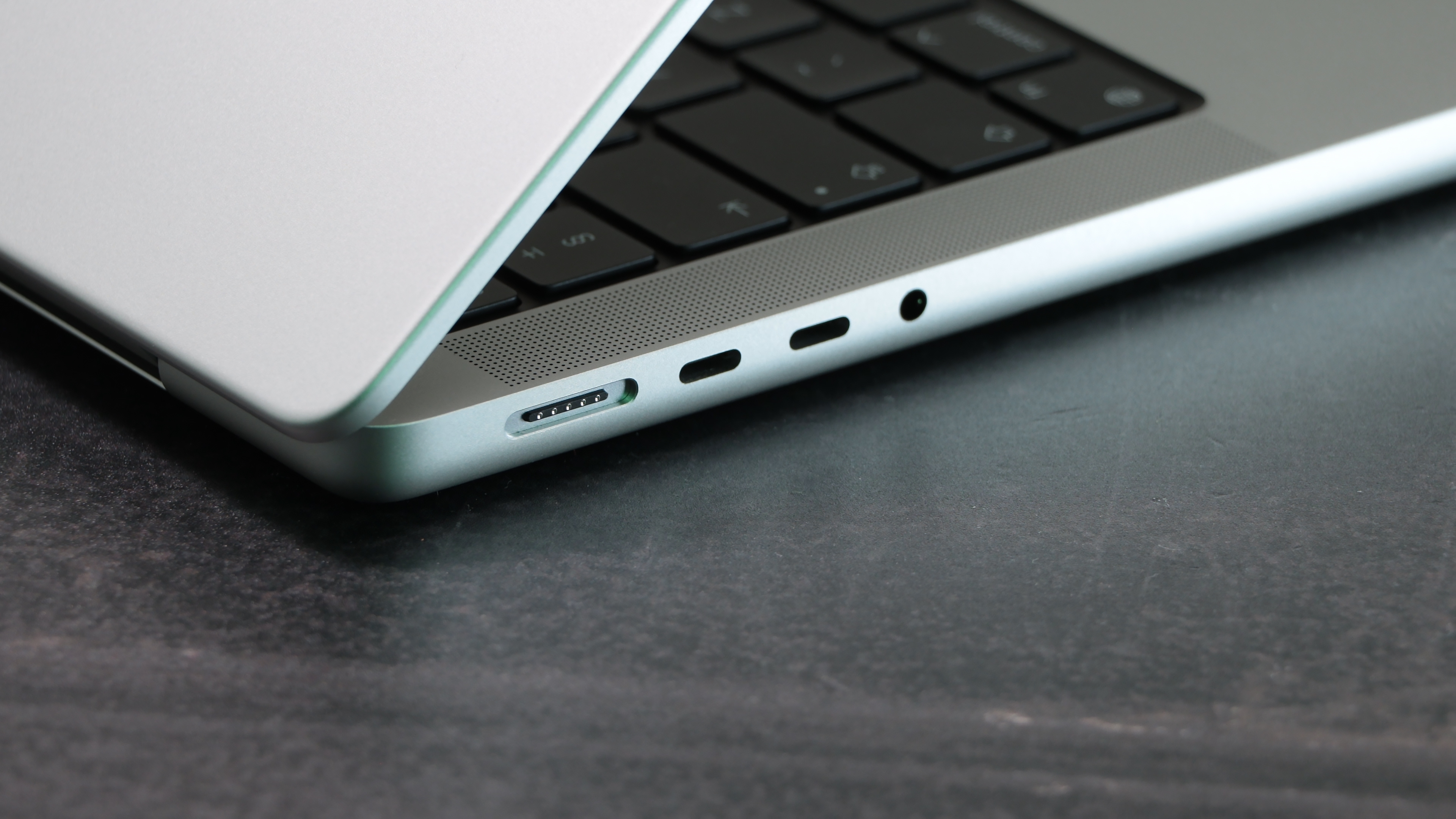
Apple MacBook Pro 14-inch (2023) review: Performance
- macOS is fast and responsive
- Easily handles heavy workloads
Here’s how the MacBook Pro 14-inch (2023) performed in our suite of benchmark tests:
Cinebench R23 CPU: Single-Core: 1,648; Multi-Core: 14,777
Geekbench 5 Single-Core: 1,965; Multi-Core: 15,044
PugentBench Photoshop: 1,067
PugentBench Premier Pro: 959
Blender: Monster: 126.12; Junkshop: 73.49; Classroom: 56.22
Battery Life (TechRadar movie test): 19 hours and 9 minutes
The MacBook Pro 14-inch (2023) debuted alongside the M2 Pro and M2 Max, Apple’s latest chips that power its MacBooks, and which are follow-ups to the M1 Pro and M1 Max that arrived with the original 14-inch MacBook Pro.
Each of these chips has two variants; the M2 Pro can come with either 10 or 12 CPU cores and 16 or 19 GPU cores, while the M2 Max packs 12 CPU cores in both versions, but can utilize either 30 or 38 GPU cores.
These new chips deliver even better performance than the excellent M1 Pro and M1 Max, although if you have the previous model, you’re unlikely you’ll feel the need to upgrade. Why? Because the M1 Pro and M1 Max remain outstanding performers, and you’d be hard-pushed to max out either of those chips in all but the most intensive workloads.
However, if you’re thinking of upgrading from an M1 MacBook – or even an Intel-powered Mac – then you're going to enjoy a substantial performance boost, with Apple claiming up to six times the performance in effects rendering than an Intel-based MacBook, and up to 2.5 times in code-compiling.
The MacBook Pro 14-inch (2023) model we were sent comes with the M2 Pro chip with a 12-core CPU and 19-core GPU, plus 32GB of unified memory. This isn’t one of the ready-made models available, but one configured to have additional memory.
While it would have been nice to give the M2 Max-toting MacBook Pro 14-inch a try (as I’ve already reviewed the M2 Pro in the MacBook Pro 16-inch (2023) and Mac mini (2023), to be fair, the M2 Pro model is going to be the most mainstream edition, as the M2 Max offers the kind of power that not many people will need. The 32GB of memory is a decent upgrade that I’d recommend to people who can afford it, as the 16GB that comes as standard with the M2 Pro MacBooks may start holding you back in a few years; and as it’s installed directly on the chip, you won’t be able to upgrade it (not that previous MacBooks were upgradable).

As it’s unified memory, it acts as both standard RAM and video RAM, so if you’re going to be doing a lot of graphics-intensive work, the more memory you configure with it, the better, and you can get up to 96GB of the stuff… though that is likely overkill.
Because of the similarity in hardware between the MacBook Pro 16-inch (2023) and MacBook Pro 14-inch (2023) I tested, both powered by the M2 Pro chip, results in the synthetic benchmarks I ran were essentially the same. This means you shouldn’t see any noticeable difference in performance depending on which screen size you prefer. What will make a big difference, however, is the configurations you choose when you buy either MacBook.
Despite having the ‘weaker’ M2 Pro, I found that the MacBook Pro 14-inch (2023) handled everything I threw at it. As with the 16-inch model, I used the MacBook Pro 14-inch (2023) to edit videos in 8K (using various clips), and got it to record numerous instruments at the same time, and edit multi-track audio projects in Albeton Live 11, including complex virtual instruments from Native Instrument’s Komplete Kontrol package.
As well as using the laptop for web browsing and word processing, my tests covered a range of use cases for day-to-day to intensive workloads, and the MacBook Pro 14-inch (2023) kept up brilliantly, and at no point did I feel like I needed to have the M2 Max-powered model; macOS Ventura felt fast and responsive, and scrolling through 8K video and editing on the fly were all quick and easy.
This is a testament to the power of the M2 Pro, but it also means the M2 Max is harder to justify. If you’re going to be needing a laptop for some enterprise-grade graphical workloads, the stronger chip may be worthwhile, but for the vast majority of users, the M2 Pro will be more than enough.
For those who have an M1 Pro or M1 Max MacBook Pro, I wouldn’t be too concerned about upgrading to the M2 variants, unless you’ve found that you’re reaching the limits of what those older chips can achieve – and, again, that will likely only apply to very intensive workloads. The M1 Pro and M1 Max remain impressive performers, and from what I’ve seen of the M2 Pro, and what Apple has told me of the M2 Max, I don’t think you’ll see a generational leap between the chips that would justify the outlay, and it may be better to wait for a potential M3 Pro and M3 Max, which are very likely to show up in the future and bring yet another leap in performance.
Still, the MacBook Pro 14-inch (2023) is a brilliant performer, and brings desktop-class performance to a compact laptop.
- Performance score: 5/5
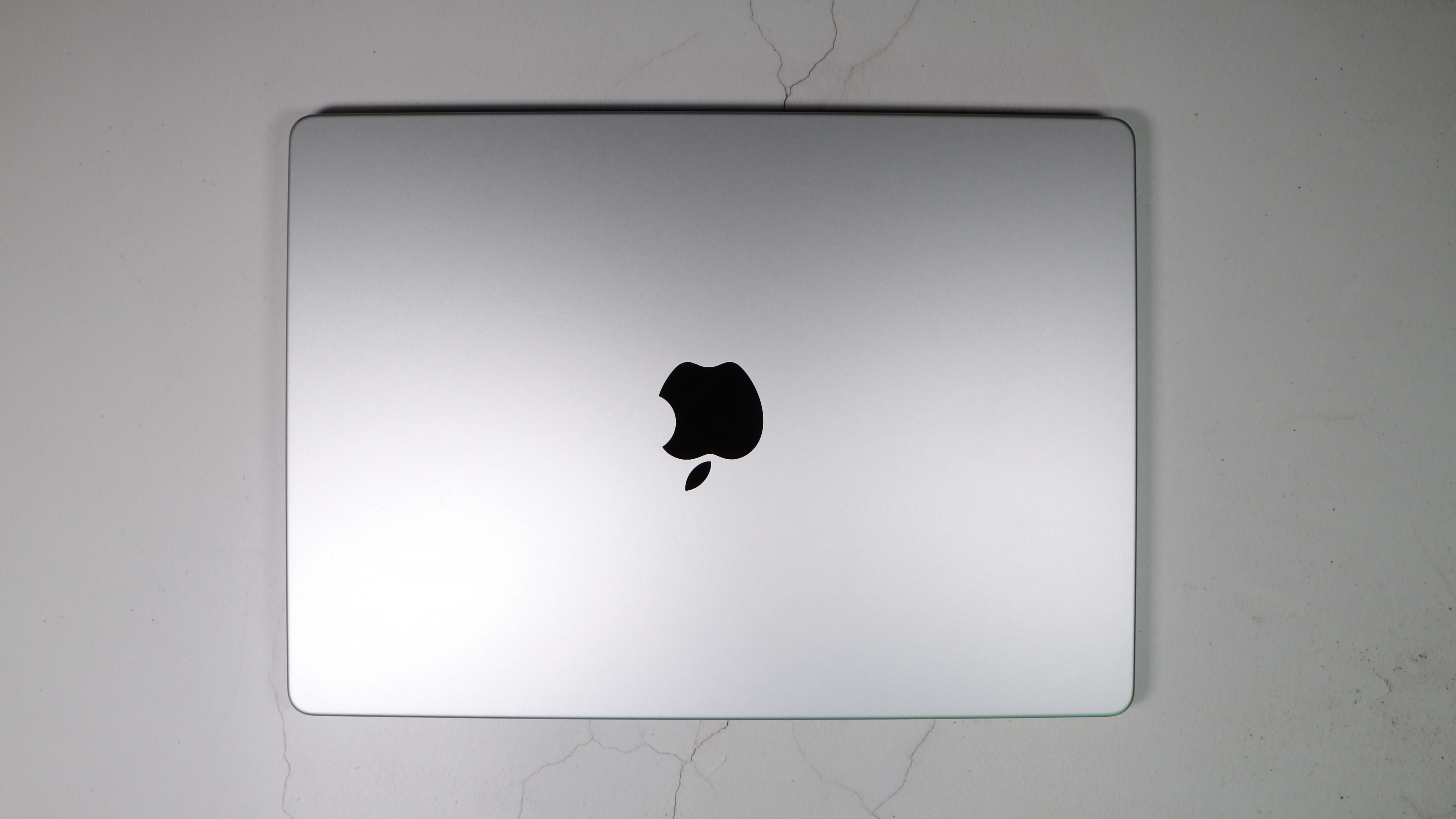
Apple MacBook Pro 14-inch (2023) review: Battery life
- Lasts more than 19 hours on a single charge
- Three hours longer than previous model
The MacBook Pro 14-inch comes with a 70 watt-hour battery life, which Apple claims offers up to 18 hours of video playback and 12 hours of web browsing. Those are big claims, but as we’ve seen with the 16-inch model, the M2 Pro (and M2 Max) aren’t just very powerful; they're efficient as well, which means they don’t drain the battery life as quickly when not being used for intensive tasks.
The MacBook Pro 16-inch (2023)'s battery life positively blew me away when I reviewed it. In our battery benchmark, which involves playing a looped 1080p video until it turns off, the laptop managed an epic 19 hours and 39 minutes. For a workstation laptop that offers the kind of power both these new MacBook Pros provide, that’s seriously impressive.
Due to its size, the MacBook Pro 16-inch (2023) gets a larger 100 watt-hour battery, but I still had high hopes for the MacBook Pro 14-inch, and I wasn’t disappointed. In the same battery benchmark, the MacBook Pro 14-inch (2023) managed an excellent 19 hours and nine minutes.
Despite the smaller battery, the 14-inch MacBook Pro doesn’t have a much shorter battery life, which is likely due to it not having to power as big a screen. It’s an excellent showing, and it means you can easily go for a few work days without needing to plug it in.
While more intensive tasks will cause it the drain more quickly, the battery life means this is a workstation laptop that you can rely on when you're on the move. It also outlasts the previous model by just over three hours.
When charging via the MagSafe 3 port, the battery tops up quickly; you can also charge it over USB-C, and while that’s not as fast, it means you can borrow a USB-C charger from another laptop if you leave your MagSafe 3 charger behind.
Should you buy the MacBook Pro 14-inch (2023)?
| Attributes | Notes | Rating |
|---|---|---|
| Price | Same price as previous model in the US, but UK and Australia get price rises | 4/5 |
| Design | No new design, but screen remains perfect | 5/5 |
| Performance | Incredible performance, even when on battery | 5/5 |
| Battery life | Almost 20 hours of battery life is extremely impressive | 5/5 |
Buy it if...
You need a workstation to travel with
The MacBook Pro 14-inch (2023)’s smaller size means it’s easier to carry around than the 16-inch model, but still offers the same excellent performance.
You need long battery life
With a battery life of just shy of 20 hours, the MacBook Pro 14-inch (2023) is a fantastic choice for people looking for a laptop with a long battery life.
You’re a creative professional
The power on offer in the MacBook Pro 14-inch (2023) in any configuration is best suited for people who need a laptop that can tackle heavy creative workloads.
Don't buy it if...
You don’t need the power
Not everyone will need the performance that the MacBook Pro 14-inch (2023) offers, and there are better-value laptops out there.
You prefer larger screen sizes
If you think the 14-inch screen is going to be too small to work on without plugging it into a monitor, then paying extra for the 16-inch model will be wise.
You have a 2021 MacBook Pro
You really don’t need to upgrade from an M1 Pro or M1 Max MacBook Pro – you’d be better off waiting for the next generation to come along.
MacBook Pro 14-inch (2023) review: Also consider
| MacBook Pro M2 Pro 14-inch (2023) | MacBook Air (M2, 2022) | Dell XPS 13 Plus | |
|---|---|---|---|
| Price: | $1,999 / £2,149 / AU$3,199 | $1,199 / £1,249 / AU$1,899 | $1,299 / £1,399 / AU$2,339 |
| CPU: | Apple M2 Pro (10-core) | Apple M2 (8-core) | Intel Core i7-1280P (14-core) |
| Graphics: | Integrated 16-core GPU | Integrated 10-core GPU | Intel Iris Xe |
| RAM: | 16GB unified memory | 8GB unified memory | 16GB LPDDR5 |
| Screen: | 14.2-inch, 3024 x 1964 Liquid Retina XDR display (mini-LED, 1,000 nits sustained brightness, wide color P3 gamut, ProMotion technology) | 13.6-inch, 2,560 x 1,664 Liquid Retina display (backlit LED, IPS, 500 nits brightness, wide color P3 gamut) | 13.4-inch, 3,456 x 2,160, 60Hz, OLED, Touch, Anti-Reflect, 400 nit |
| Storage: | 512GB | 256GB | 512GB |
| Ports: | 3x Thunderbolt 4 (USB-C), HDMI, SDXC card slot, 3.5mm headphone jack, MagSafe 3 | 2x Thunderbolt 3 (USB-C), 3.5mm headphone jack, MagSafe 3 charging port | 2 x Thunderbolt 4 (USB-C) |
| Wireless: | Wi-Fi 6e (802.11ax), Bluetooth 5.3 | Wi-Fi 6, Bluetooth 5.0 | Wi-Fi 6, Bluetooth 5.2 |
| Camera: | 1080p FaceTime HD webcam | 1080p FaceTime HD webcam | 720p, 30 FPS HD |
| Weight: | 3.5 lbs (1.6kg) | 2.7 pounds (1.24kg) | 2.77 pounds (1.26kg) |
| Dimensions: | 12.31 x 8.71 x 0.61 inches (313 x 221 x 16mm) | 11.97 x 8.46 x 0.44 inches (30.41 x 21.5 x 1.13cm; W x D x H) | 11.63 x 7.84 x 0.60 inches (29.54 x 19.91 x 1.52 cm) |
If our Apple MacBook Pro 14-inch (2023) review has you considering other options, here are two laptops to consider...
Apple MacBook Air (M2, 2022)
The follow-up to one of the best laptops ever released, the 2022 MacBook Air is svelte and sleek, with a larger screen and the same outstanding battery life. If you want a MacBook, but don't need the power of the MacBook Pro 14-inch, this is the one to get.
Check out our Apple MacBook Air (M2, 2022) review
Dell XPS 13 Plus
Its sleek and slim design, combined with a gorgeous OLED screen, great sound quality, and lattice-free keyboard embodies the luxury inherit of an Ultrabook. However, it’s also prone to overheating, and the touch bar is annoyingly inaccessible.
Read more: Dell XPS 13 Plus review
How I tested the Apple MacBook Pro 14-inch (2023)
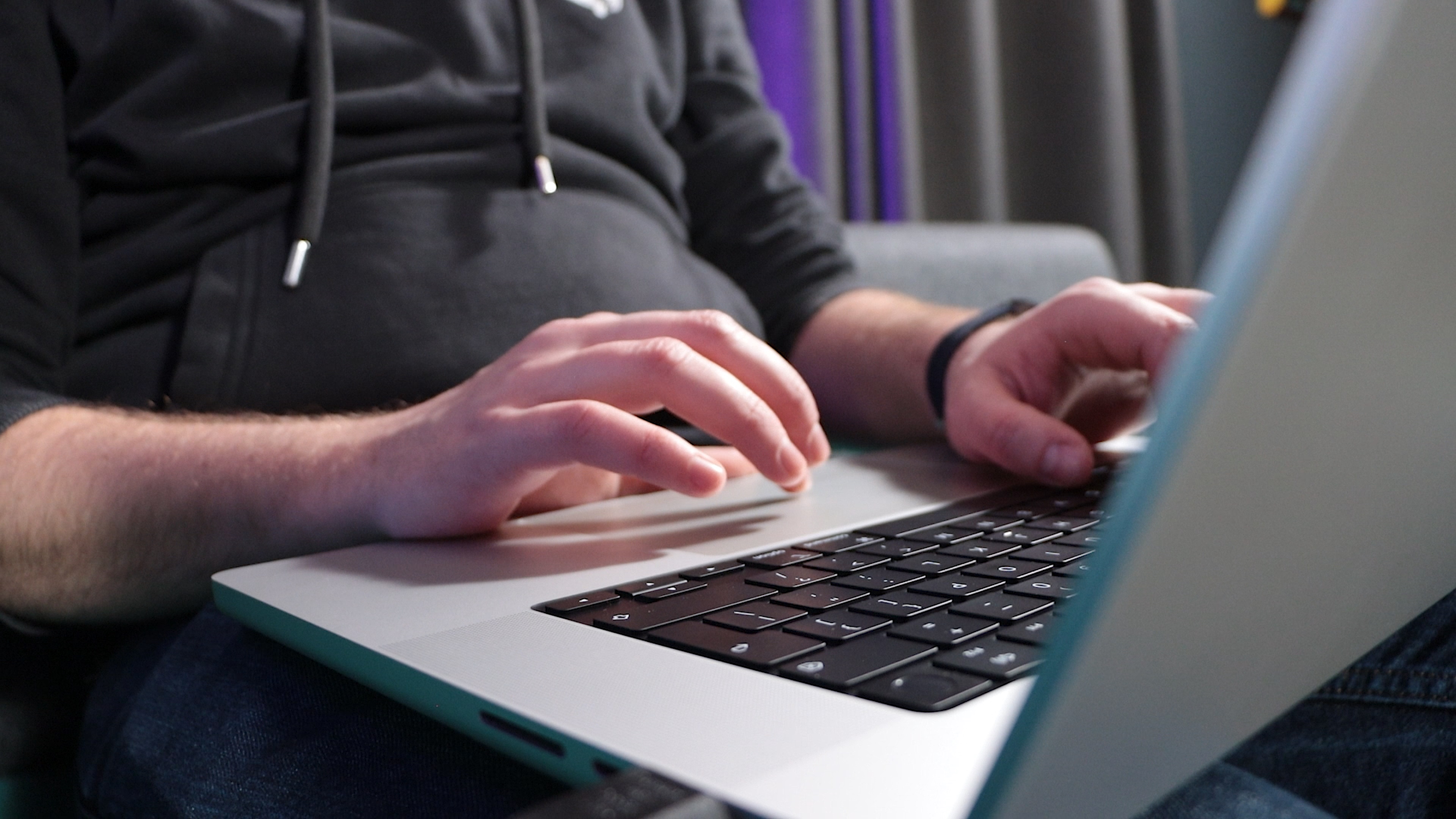
- I spent two weeks using the MacBook Pro 14-inch (2023)
- I edited 8K videos and made music on it
- I ran our usual suite of standardized benchmarks
Apple sent me the 14-inch MacBook Pro (2023) around a week after I’d finished my 16-inch MacBook Pro review, and because of a holiday and other work commitments, it allowed me to take my time with the 14-inch model, using it for a variety of tasks over about two weeks.
This included browsing the web and writing and uploading articles to TechRadar, as well as editing 8K videos in Adobe Premiere Pro and making multi-track music using MIDI devices and external instruments.
I also watched a few TV shows on Apple TV+ using the MacBook Pro 14-inch. Over this time I was able to see how the MacBook Pro 14-inch performed in typical scenarios. I also ran our suite of benchmark tests, which gave me an insight into the performance of the MacBook Pro 14-inch (2023) when under intensive load, and compared it to other laptops that were put through the same tests.
First reviewed February 2023

Matt is TechRadar's Managing Editor for Core Tech, looking after computing and mobile technology. Having written for a number of publications such as PC Plus, PC Format, T3 and Linux Format, there's no aspect of technology that Matt isn't passionate about, especially computing and PC gaming. He’s personally reviewed and used most of the laptops in our best laptops guide - and since joining TechRadar in 2014, he's reviewed over 250 laptops and computing accessories personally.
